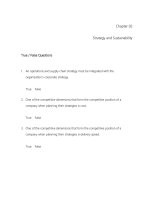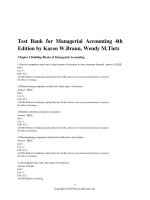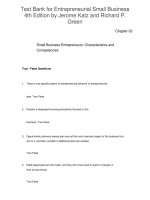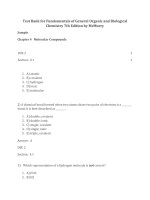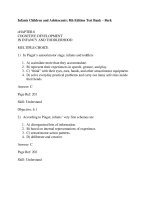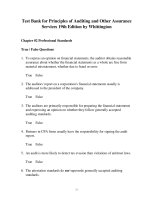link full download test bank for operations and supply chain management the core 3rd edition by f robert jacobs and richard chase
Bạn đang xem bản rút gọn của tài liệu. Xem và tải ngay bản đầy đủ của tài liệu tại đây (334.61 KB, 51 trang )
Test Bank for Operations and Supply Chain Management The
Core 3rd Edition
Chapter 01
Operations and Supply Chain Management
True / False Questions
1. Efficiency means doing the right things to create the most value for the
company. True False
2. Effectiveness means doing the right things to create the most value for
the company.
True False
3. A doctor completes a surgical procedure on a patient without error. The patient
dies anyway. In operations management terms, we could refer to this doctor
as being efficient but not effective.
True False
4. A worker can be efficient without being
effective. True False
5. A process can be effective without being
efficient. True False
6. Operations and supply chain management is defined as the design,
operation, and improvement of the systems that create and deliver the firm's
primary products and services.
True False
7. The term "value" refers to the relationship between quality and the price paid
by the consumer.
True False
8. Attempting to balance the desire to efficiently use resources while providing
a highly effective service may create conflict between the two goals.
True False
9. Central to the concept of operations strategy are the notions of operations
focus and trade-offs.
True False
10. OSCM is concerned with management of the trickiest parts of the system
that produces a good or delivers a service.
True False
11. OSCM is a functional field of business with clear line
management responsibilities.
True False
12. The supply network as can be thought of as a pipeline through which
cash, material and information flows.
True False
13. Supply networks cannot be constructed for every product or
service. True False
14. "Operations" refers to manufacturing and service processes used to
transform resources employed by a firm into products desired by customers.
True False
15. "Supply Chain" refers to processes that move information and material to
and from the manufacturing and service processes of the firm.
True False
16. "Supply Chain" includes only inbound freight and
inventory. True False
17. It is critical that a sustainable strategy meet the needs of shareholders and
employees. It is also highly desirable that it preserves the environment.
True False
18. Planning is where a firm must determine how anticipated demand will be met
with available resources.
True False
19. Although planning involves determining how the various supply chain
processes (sourcing, making, delivering, and returning) will be met, planning
itself is not considered a supply chain process.
True False
20. The supply chain processes mentioned in the textbook are: planning,
sourcing, delivering, and returning.
True False
21. All managers should understand the basic principles that guide the design
of transformation processes.
True False
22. Operations and supply management changes constantly because of the
dynamic nature of competing in global business and the constant evolution of
information technology.
True False
23. Internet technology has made the sharing of reliable real-time information
expensive.
True False
24. Capturing information directly from the source through such systems as pointof-sale, radio-frequency identification tags, bar-code scanners, and automatic
recognition has had little impact on Operations and Supply Chain Management.
True False
25. Use of systems like point-of-sale, radio-frequency identification tags, bar-code
scanners, and automatic recognition has made it more difficult to understand
what all the information is saying.
True False
26. Operations and supply chain processes can be conveniently categorized
as planning, sourcing, making, and delivering.
True False
27. A major aspect of planning involves developing a set of metrics to monitor
the supply chain.
True False
28. Returning involves processes for receiving worn-out, defective, and excess
products back from customers but does not involve support for customers
who have problems with the product.
True False
29. Delivering is not considered in supply chain analysis when outside carriers
are contracted to move products to customers.
True False
30. Services are intangible processes that cannot be weighed or
measured. True False
31. Service innovations can be
patented. True False
32. Services are
homogeneous. True False
33. Services are defined and evaluated as a package of features that affect the
five senses.
True False
34. Automobiles and appliances are classified as "pure
goods." True False
35. Core service providers integrate tangible goods into their
product. True False
36. "Product-service bundling" refers to a company building service activities into
its product offerings for its customers.
True False
37. In contrast to careers in finance and marketing, careers in OSCM involve
hands-on involvement with people and processes.
True False
38. A bank branch manager position is not an OSCM-type of
job. True False
39. A supply chain manager is an OSCM job while a purchasing manager is
not. True False
40. Just in time (JIT) production was a major breakthrough in
manufacturing philosophy pioneered by the Japanese.
True False
41. Lean manufacturing refers to just in time production coupled with total
quality control.
True False
42. The Baldrige National Quality Award was started under the direction of
the National Institute of Standards and Technology.
True False
43. The approach that advocates making revolutionary changes as opposed
to evolutionary changes is called creation theory.
True False
44. The approach that advocates making revolutionary changes as opposed
to evolutionary changes is called "business process reengineering."
True False
45. Business process reengineering, which seeks revolutionary change, is contrasted
with total quality management which commonly advocates incremental change.
True False
46. The "triple bottom line" relates to the economic, employee, and
environmental impact of a firm's strategy.
True False
47. Sustainability is the ability to maintain profits in a
system. True False
48. Raising senior management awareness of OSCM as a competitive weapon is
not an important issue.
True False
49. "Green belt" programs are coordinated public works projects aimed a placing
an environmentally friendly zone around major cities.
True False
50. Green and black belt programs teach six-sigma quality tools to managers at
many corporations.
True False
51. The central idea of supply chain management is to apply a total system
approach to managing the flow of information, materials, and services from raw
material suppliers through factories and warehouses to the end customer.
True False
52. The term "electronic commerce" refers to the buying and selling of
electronic products and devices.
True False
53. The term "electronic commerce" refers to the use of the internet as an
essential element of business activity.
True False
54. SSME is an acronym standing for "Service Sector Management
Economics." True False
55. Science Management and Engineering aims to apply the latest concepts in
information technology to continue to improve service productivity of
technology-based organizations.
True False
56. "Business Analytics" involves the analysis of data through a unique combination
of linear programming, game theory and queuing theory to better solve
business problems.
True False
57. The mathematical results of Business Analytics are used to automate decisionmaking and eliminate the decision maker.
True False
58. Operations and supply chain strategy are not important issues to investors
who tend to focus on growth, dividends and earnings per share.
True False
59. Investors pay close attention to efficiency and productivity measures like net
income per employee because they are interested in how well the firm
manages its workforce relations.
True False
60. During a recession, efficient firms often have an opportunity to increase
market share while maintaining profitability.
True False
61. Wall Street analysts are not particularly concerned with how efficient
companies are from an operations and supply management view.
True False
Multiple Choice Questions
62. One reason for studying operations and supply chain management (OSCM)
is which of the following?
A. OSCM is essential for understanding organizational behavior
B. Most business graduates do OSCM work regardless of their job title
C. All managers should understand the basic principles that guide the design
of transformation processes.
D. OSCM is a required course in all business degree programs
E. OSCM is the most rigorous business discipline
63. The Goods-Services Continuum consists of which set of the
following categories?
A. No goods, some goods, even mix, some service, no service
B. Pure goods, core goods, core services, pure services
C. No service, some service, good service, excellent service
D. Self-service, help desk service, face-to-face service, service-with-a-simle
E. None of the above
64. Which of the following are defined as core goods?
A. Chemicals
B. Airlines
C. Data storage systems
D. Hotels
E. None of the above
65. Current issues in OSCM do not include:
A. Coordinating relationships between organizations.
B. Making senior management aware that OSCM can be a competitive weapon.
C. The triple bottom line.
D. Managing customer touch points.
E. Increasing global supply chain employment.
66. Which of the following are not listed in the text as jobs in OSCM?
A. Department store manager
B. Project manager
C. Hospital administrator
D. Data Center manager
E. Call center manager
67. Which of the following is not a characteristic that distinguishes services
from goods?
A. Service jobs are unskilled.
B. A service is intangible.
C. Services are perishable
D. Services are heterogeneous
E. None of the above
68. Which of the following is not a way that operations and supply processes
are categorized?
A. Planning
B. Return
C. Delivery
D. Selecting
E. Making
69. One of the "package of features" that make up a service is:
A. Appearance
B. Facilitating goods
C. Packaging
D. Cost
E. Implied use
70. Which of the following is not a measure of operations and supply
chain management efficiency used by Wall Street?
A. Inventory turnover
B. Revenue per employee
C. Receivable turnover
D. Earnings per share
E. Asset turnover
71. Which of the following is a measure of operations and supply
management efficiency used by Wall Street?
A. Dividend payout ratio
B. Current ratio
C. Receivable turnover
D. Earnings per share growth
E. Financial leverage
Fill in the Blank Questions
72. The ability to maintain balance in a system is referred to as _______________.
________________________________________
73. Processes that are used to transform resources into products are called
________________.
________________________________________
74. What are the five categories of supply chain processes?
1.___________________
2.___________________
3.___________________
4.___________________
5.___________________
________________________________________
75. Doing something at the lowest possible cost is called: ________________.
________________________________________
76. Value is the ratio of ___________________________.
________________________________________
77. A pipeline through which material and information flows is a conception of a
_______________________.
________________________________________
78. List five OSCM job titles.
1.___________________
2.___________________
3.___________________
4.___________________
5.___________________
________________________________________
79. What are four current issues in operations and supply management that
are discussed in the textbook?
1.___________________
2.___________________
3.___________________
4.___________________
________________________________________
80. What is a total systems approach to managing the flow of information, materials,
and services from raw material suppliers through factories and warehouses to
the end customer called? ________________________________
________________________________________
81. What is a major industry and university program aiming to apply the latest
concepts in information technology to continue to improve service productivity
of technology-based organizations called?
_____________________________________________
________________________________________
82. The use of the internet as an essential element of business activity is
called what? ______________________________
________________________________________
83. Name five common measures of operations and supply management
efficiency used by Wall Street.
1. _____________________
2. _____________________
3. _____________________
4. _____________________
5. _____________________
________________________________________
Essay Questions
84. Discuss the role of efficiency and effectiveness in the creation of value.
Chapter 01 Operations and Supply Chain Management Answer Key
True / False Questions
1.
the
Efficiency means doing the right things to create the most value for
(p. 10)
company.
FALSE
Efficiency means doing something at the lowest possible cost.
AACSB: Analytic
Blooms: Remember
Difficulty: 1 Easy
Learning Objective: 01-03 Define efficient and effective operations.
Topic: Efficiency, Effectiveness, and Value
2.
the
Effectiveness means doing the right things to create the most value for
(p. 10)
company.
TRUE
Effectiveness means doing the right things to create the most value for the
company.
AACSB: Analytic
Blooms: Remember
Difficulty: 1 Easy
Learning Objective: 01-03 Define efficient and effective operations.
Topic: Efficiency, Effectiveness, and Value
3.
(p. 10)
A doctor completes a surgical procedure on a patient without error. The patient
dies anyway. In operations management terms, we could refer to this doctor as
being efficient but not effective.
TRUE
Efficiency means doing something at the lowest possible cost. Effectiveness
means doing the right things to create the most value. The doctor performed
the surgery without error. Because the patient died, no value was created.
AACSB: Analytic
Blooms: Analyze
Difficulty: 2 Medium
Learning Objective: 01-03 Define efficient and effective operations.
Topic: Efficiency, Effectiveness, and Value
4.
A worker can be efficient without being effective.
(p. 11)
TRUE
Efficiency means doing something at the lowest possible cost. Effectiveness
means doing the right things to create the most value. These are different
things.
AACSB: Analytic
Blooms: Understand
Difficulty: 2 Medium
Learning Objective: 01-03 Define efficient and effective operations.
Topic: Efficiency, Effectiveness, and Value
5.
A process can be effective without being efficient.
(p. 11)
TRUE
Often, maximizing effectiveness and efficiency at the same time creates conflict
between the two goals. "Being efficient" at the customer service counter at a
local store or bank means using the smallest number of clerks possible at the
counter. Being effective, though, means minimizing the amount of time
customers need to wait in line.
AACSB: Analytic
Blooms: Understand
Difficulty: 2 Medium
Learning Objective: 01-03 Define efficient and effective operations.
Topic: Efficiency, Effectiveness, and Value
6.
(p. 4)
Operations and supply chain management is defined as the design, operation,
and improvement of the systems that create and deliver the firm's primary
products and services.
TRUE
Operations and supply chain management is defined as the design, operation,
and improvement of the systems that create and deliver the firm's primary
products and services.
AACSB: Analytic
Blooms: Remember
Difficulty: 1 Easy
Learning Objective: 01-01 Understand operations and supply chain processes and why it is important to study them.
Topic: What is Operations and Supply Chain Management?
7.
(p. 11)
The term "value" refers to the relationship between quality and the price paid
by the consumer.
TRUE
Related to efficiency and effectiveness is the concept of value, which can be
metaphorically defined as quality divided by price.
AACSB: Analytic
Blooms: Remember
Difficulty: 1 Easy
Learning Objective: 01-03 Define efficient and effective operations.
Topic: Efficiency, Effectiveness, and Value
8.
(p. 10)
Attempting to balance the desire to efficiently use resources while providing a
highly effective service may create conflict between the two goals.
TRUE
Often maximizing effectiveness and efficiency at the same time creates conflict
between the two goals.
AACSB: Analytic
Blooms: Analyze
Difficulty: 1 Easy
Learning Objective: 01-03 Define efficient and effective operations.
Topic: Efficiency, Effectiveness, and Value
9.
(p. 18)
Central to the concept of operations strategy are the notions of operations
focus and trade-offs.
TRUE
Central to their thinking was the notion of factory focus and manufacturing
trade-offs. Because a factory cannot excel on all performance measures, its
management must devise a focused strategy, (to perform) a limited set of tasks
extremely well. This requires trade-offs.
AACSB: Analytic
Blooms: Remember
Difficulty: 1 Easy
Learning Objective: 01-05 Learn how the field has developed over time.
Topic: Historical Development of Operations and Supply Chain Management
10.
(p. 4)
OSCM is concerned with management of the trickiest parts of the system that
produces a good or delivers a service.
FALSE
OSCM is concerned with the management of the entire system that produces a
good or delivers a service.
AACSB: Analytic
Blooms: Remember
Difficulty: 1 Easy
Learning Objective: 01-01 Understand operations and supply chain processes and why it is important to study them.
Topic: What is Operations and Supply Chain Management?
11.
(p. 4)
OSCM is a functional field of business with clear line management
responsibilities.
TRUE
OSCM is a functional field of business with clear line management
responsibilities.
AACSB: Analytic
Blooms: Remember
Difficulty: 1 Easy
Learning Objective: 01-01 Understand operations and supply chain processes and why it is important to study them.
Topic: What is Operations and Supply Chain Management?
12.
(p. 6)
The supply network as can be thought of as a pipeline through which cash,
material and information flows.
FALSE
Think of the supply network as a pipeline through which material and
information flows.
AACSB: Analytic
Blooms: Understand
Difficulty: 1 Easy
Learning Objective: 01-01 Understand operations and supply chain processes and why it is important to study them.
Topic: What is Operations and Supply Chain Management?
13.
Supply networks cannot be constructed for every product or service.
(p. 6)
FALSE
Networks such as this can be constructed for any product or service.
AACSB: Analytic
Blooms: Understand
Difficulty: 1 Easy
Learning Objective: 01-01 Understand operations and supply chain processes and why it is important to study
them.
Topic: What is Operations and Supply Chain Management?
(p. 6)
14.
"Operations" refers to manufacturing and service processes used to
transform
resources employed by a firm into products desired by customers.
TRUE
Operations refers to manufacturing, service, and health care processes that are
used to transform the resources employed by a firm into products desired by
customers.
AACSB: Analytic
Blooms: Remember
Difficulty: 1 Easy
Learning Objective: 01-01 Understand operations and supply chain processes and why it is important to study them.
Topic: What is Operations and Supply Chain Management?
(p. 7)
15.
"Supply Chain" refers to processes that move information and material
to and
from the manufacturing and service processes of the firm.
TRUE
Supply chain refers to processes that move information and material to and
from the manufacturing and service processes of the firm.
AACSB: Analytic
Blooms: Remember
Difficulty: 1 Easy
Learning Objective: 01-01 Understand operations and supply chain processes and why it is important to study
them.
Topic: What is Operations and Supply Chain Management?
16.
"Supply Chain" includes only inbound freight and inventory.
(p. 7)
FALSE
Supply chain refers to processes that move information and material to and
from the manufacturing and service processes of the firm.
AACSB: Analytic
Blooms: Understand
Difficulty: 2 Medium
Learning Objective: 01-01 Understand operations and supply chain processes and why it is important to study them.
Topic: What is Operations and Supply Chain Management?
17.
(p. 6)
It is critical that a sustainable strategy meet the needs of shareholders and
employees. It is also highly desirable that it preserves the environment.
FALSE
A sustainable strategy that meets the needs of shareholders and employees
while preserving the environment is critical.
AACSB: Analytic
Blooms: Understand
Difficulty: 2 Medium
Learning Objective: 01-01 Understand operations and supply chain processes and why it is important to study them.
Topic: What is Operations and Supply Chain Management?
18.
(p. 7)
Planning is where a firm must determine how anticipated demand will be met
with available resources.
TRUE
Planning consists of the processes needed to operate an existing supply chain
strategically. Here a firm must determine how anticipated demand will be met
with available resources.
AACSB: Analytic
Blooms: Understand
Difficulty: 1 Easy
Learning Objective: 01-01 Understand operations and supply chain processes and why it is important to study them.
Topic: Operations and Supply Chain Processes
19.
(p. 7)
Although planning involves determining how the various supply chain
processes (sourcing, making, delivering, and returning) will be met, planning
itself is not considered a supply chain process.
FALSE
Operations and supply chain processes can be conveniently categorized…as
planning, sourcing, making, delivering, and returning.
AACSB: Analytic
Blooms: Understand
Difficulty: 1 Easy
Learning Objective: 01-01 Understand operations and supply chain processes and why it is important to study them.
Topic: Operations and Supply Chain Processes
20.
(p. 7)
The supply chain processes mentioned in the textbook are: planning, sourcing,
delivering, and returning.
FALSE
Operations and supply chain processes can be conveniently categorized…as
planning, sourcing, making, delivering, and returning.
AACSB: Analytic
Blooms: Understand
Difficulty: 1 Easy
Learning Objective: 01-01 Understand operations and supply chain processes and why it is important to study them.
Topic: Operations and Supply Chain Processes
21.
(p. 7)
All managers should understand the basic principles that guide the design of
transformation processes.
TRUE
All managers should understand the basic principles that guide the design of
transformation processes.
AACSB: Analytic
Blooms: Remember
Difficulty: 1 Easy
Learning Objective: 01-01 Understand operations and supply chain processes and why it is important to study them.
Topic: What is Operations and Supply Chain Management?
22.
(p. 7)
Operations and supply management changes constantly because of the
dynamic nature of competing in global business and the constant evolution of
information technology.
TRUE
The field of operations and supply management is ever changing due to the
dynamic nature of competing in global business and the constant evolution of
information technology.
AACSB: Analytic
Blooms: Remember
Difficulty: 1 Easy
Learning Objective: 01-05 Learn how the field has developed over time.
Topic: What is Operations and Supply Chain Management?
23.
(p. 7)
Internet technology has made the sharing of reliable real-time information
expensive.
FALSE
Internet technology has made the sharing of reliable real-time information
inexpensive.
AACSB: Analytic
Blooms: Remember
Difficulty: 1 Easy
Learning Objective: 01-05 Learn how the field has developed over time.
Topic: What is Operations and Supply Chain Management?
24.
(p. 7)
Capturing information directly from the source through such systems as pointof-sale, radio-frequency identification tags, bar-code scanners, and automatic
recognition has had little impact on Operations and Supply Chain
Management.
FALSE
Capturing information directly from the source through such systems as point-ofsale, radio-frequency identification tags, bar-code scanners, and automatic
recognition has shifted the focus to understanding both what all the information is
saying and also how good are the decisions that can be made using it.
AACSB: Analytic
Blooms: Remember
Difficulty: 1 Easy
Learning Objective: 01-05 Learn how the field has developed over time.
Topic: What is Operations and Supply Chain Management?
25.
(p. 7)
Use of systems like point-of-sale, radio-frequency identification tags, bar-code
scanners, and automatic recognition has made it more difficult to understand
what all the information is saying.
FALSE
Capturing information directly from the source through such systems as pointof-sale, radio-frequency identification tags, bar-code scanners, and automatic
recognition has shifted the focus to understanding both what all the information
is saying and also how good are the decisions that can be made using it.
AACSB: Analytic
Blooms: Understand
Difficulty: 1 Easy
Learning Objective: 01-05 Learn how the field has developed over time.
Topic: What is Operations and Supply Chain Management?
26.
(p. 7)
Operations and supply chain processes can be conveniently categorized as
planning, sourcing, making, and delivering.
FALSE
Operations and supply chain processes can be conveniently categorized as
planning, sourcing, making, delivering, and returning.
AACSB: Analytic
Blooms: Remember
Difficulty: 2 Medium
Learning Objective: 01-01 Understand operations and supply chain processes and why it is important to study them.
Topic: Operations and Supply Chain Processes
27.
(p. 7)
A major aspect of planning involves developing a set of metrics to monitor the
supply chain.
TRUE
A major aspect of planning is developing a set of metrics to monitor the supply
chain so that it is efficient and delivers high quality and value to customers.
AACSB: Analytic
Blooms: Remember
Difficulty: 1 Easy
Learning Objective: 01-01 Understand operations and supply chain processes and why it is important to study them.
Topic: Operations and Supply Chain Processes
28.
(p. 8)
Returning involves processes for receiving worn-out, defective, and excess
products back from customers but does not involve support for customers who
have problems with the product.
FALSE
Returning involves the processes for receiving worn-out, defective, and excess
products back from customers and support for customers who have problems
with delivered products.
AACSB: Analytic
Blooms: Remember
Difficulty: 1 Easy
Learning Objective: 01-01 Understand operations and supply chain processes and why it is important to study them.
Topic: Operations and Supply Chain Processes
